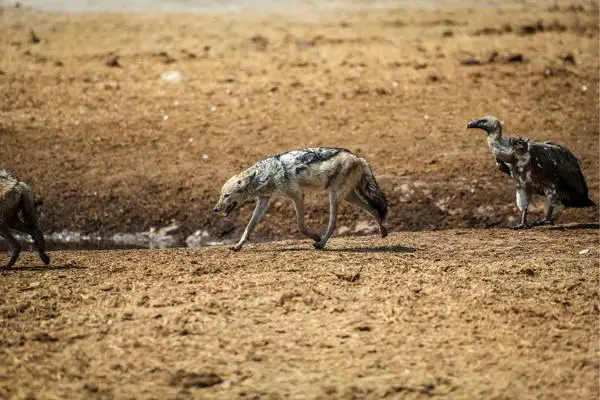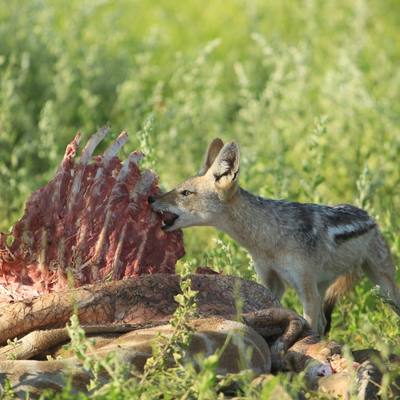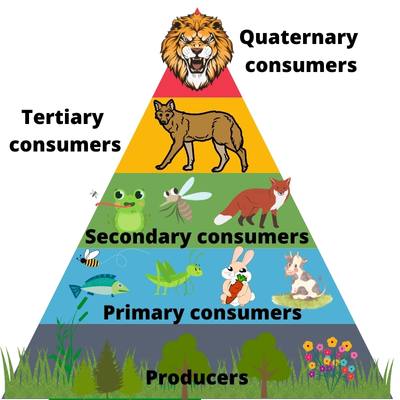Jackals are omnivorous scavengers that live off the land. In the wild, they form an important part of the food web since they eat a wide variety of food items and provide a nutritious meal to larger predators or scavenger animals.
Jackals are primary predators but can function as scavengers on the land. Whereas they mostly eat living things like rodents and small mammals, they do also eat dying or dead animals.
Jackals are opportunistic feeders that will eat anything they can get. In the wild, they mainly eat rodents, small mammals, and carrion but also grasses and fruit.
Their diet changes between seasons, as different food types become more abundant, or as they grow bigger and can handle larger food items like hares and deer.
The jackal’s skull, with powerful jaws, short snout, and broad forehead, is adapted for hunting small mammals and birds. Its long, narrow muzzle, eyes and ears, and bushy tail are adaptations for nocturnal hunting.

Jackals can run fast, up to 60 kilometers per hour for a short distance, and are good jumpers. The strong legs and feet are well adapted for digging holes and climbing.
Jackals may travel long distances over open plains in search of food and mates. They have a keen sense of smell, which helps them find food. They are known to steal food from larger predators, such as lions.
Jackals communicate through a variety of vocalizations, including barks, growls, whines, chuckles, snarls, and yowls.
Can jackals act as Scavengers or Decomposers?
Jackals are scavengers because they eat dead animals. Jackals are opportunistic feeders and are more likely to eat plants when meat is not readily available.
They are not considered real decomposers as these are only bacteria and fungi that finish off the carbon cycle and return micronutrients to the plants.
Scavengers are defined as animals that feed on the carcasses of other dead animals. Jackals certainly fit this definition, as they will often feast on the remains of other creatures.
However, jackals are also known to be opportunistic feeders, which means that they will take advantage of whatever food source is available to them.

This can sometimes mean that they only eat living animals or large amounts of plants or fruits, depending on the circumstances. Therefore, while jackals are typically considered scavengers, they will do fine without ever seeing a carcass!
Are jackals Carnivores, Herbivores or Omnivores?
Jackals are omnivores because they eat both plants and animals. They eat mainly meat, but they will also eat plants. Jackals are opportunistic feeders and are more likely to eat plants when meat is not readily available, but it depends on the type of jackal.
For example, the African golden jackal is a true jackal, as it cannot be considered a wolf, fox or dog.
While it can be considered a scavenger, it also hunts small prey such as rodents, reptiles, and birds.
While most people think of them solely as scavengers that steal from other predators’ kills, they are actually skilled hunters in their own right and often hunt alone or in pairs rather than in packs like wolves do.
They do, however, also eat a variety of plants including grasses, roots, tubers and berries and these green may constitute up to around 50% of the African golden jackal’s diet!
What Type of Consumer is a Jackal?
Jackals are mostly secondary consumers because they eat animals that are primary consumers, but they may act as all types of consumers!
They may act as both primary, secondary and tertiary consumers in a given ecological niche but rarely as quaternary consumers or apex predators as there will always be some larger predator around.
What is the role of jackals in the food chain?
In many ecosystems, jackals are an important part of the food chain. As scavengers, they help to clean up the environment by eating carcasses of dead animals and providing opportunities for prey of smaller animals to thrive.

The jackal is an important animal in the ecosystem because it is a scavenger. This gives them an important role in the ecosystem because they help to recycle nutrients and keep the environment clean.
They also prevent the spread of disease and keep populations of other animals in check. Jackals also provide a food source for predators such as lions and hyenas.
Do jackals have any natural predators?
Although jackals are high up the food chain, they are not quarternary consumers like apex predators are.
Large carnivores such as lions, tigers, and hyenas all hunt and eat jackals, as well as larger birds of prey.

However, as jackals are fairly intelligent, they have evolved to avoid being eaten by larger predators such as lions, by hunting and scavenging animals that lions do not typically hunt.
Conclusion
Jackals are an interesting group of animals. They are large, fast, opportunistic, and often seen hunting in cities!
Jackals are opportunistic, opportunists. This means that they can often be seen hunting in towns and cities, taking advantage of any food they can find. They are, however, primarily scavengers, and often eat discarded dead animals.
Sometimes, when living food is scarce, jackals will eat frogs, lizards, and eggs and they gladly also eat carrion.
Jackals are often seen as a good sign of a healthy ecosystem, as it means that they are finding enough food to sustain themselves.




